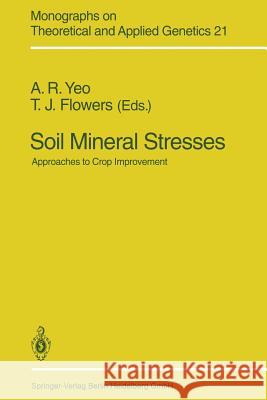Soil Mineral Stresses: Approaches to Crop Improvement » książka
Soil Mineral Stresses: Approaches to Crop Improvement
ISBN-13: 9783642842917 / Angielski / Miękka / 2014 / 218 str.
Thisbookisconcernedwiththewaysinwhichcropsmightbedevelopedfor soilsthatare, atthepresent, agriculturallyunproductivebecauseofexcesses and/ordeficienciesofcertainminerals. Wehaveconcentratedonsoils, rather thanonenvironmentalconditionsthatlimitproductivity, sincetherehavebeen anumberofrecenttextsdealingwithtopicssuchasdroughtandtemperature. Theaimisthatthoseworkingtoderivecropsforgrowthontheseproblem soilsshouldbeawareofthemanydiverseavenuesthatareavailable. These comefromthedisciplinesofplantbreeding, geneticsandphysiology, andthe interfacesthataredevelopingbetweenthem. Thebackground, therequirementstofeedtheprojectedincreaseinhuman population, issetoutintheintroductorychapter. Thenextfivechaptersthen dealwiththeapproachestocropimprovement: themeritsofaconventional breedingprogramme, theimportanceofphysiologicalcharactersinmaking selections, theuseofinvitrotechniques, ofcytogenetics, andthevalueof developingnativeplantsintocropsintheirownright. Althoughsalinityisoften usedasanexample, reflectingtheresearchinterestsofmanyoftheauthors, the methodsandapproachesdescribedhavemuchwiderapplicability.Twochap- tersarethenconcernedmorespecificallywithbreedingfortolerancetoother metaltoxicitiesandwithdeficienciesandtoxicitiesofmicronutrients. Finally, in theconcludingchapter, wesummariseandfindcommongroundbetweenthe differentapproachesandpointsofview. Brighton, April1994 ANTHONYR. YEO TIMOTHY J. FLOWERS Contents Chapter1 Introduction: WorldPopulationandAgriculturalProductivity T. 1. Flowers 1. 1 HowManyPeopleAreThere? . 1 1. 2 AgriculturalRequirements. . 2 1. 2. 1 FoodRequirements...2 1. 2. 2 FoodSupply...4 1. 3 Population-CarryingCapacity...5 1. 4 HowMuchLandIsThere? . 6 1. 5 IncreasingFoodProduction . 7 References...9 Chapter2 ConventionalPlantBreedingforTolerancetoProblemSoils C. N. ChaubeyandD. Senadhira 2. 1 ScreeningTechniques . 11 2. 2 VariabilityinToleranceforSoilStresses . 14 Rice . 15 2. 2. 1 2. 3 GeneticsofToleranceforSoilStresses...16 19 2. 3. 1 GeneLocationandLinkages...CorrelatedChanges...20 2. 3. 2 2. 4 Crop-Improvement . 21 2. 4. 1 Introduction...21 2. 4. 2 PureLineandMassSelection...21 2. 4. 3 HybridisationandSelection. 23 2. 4. 3. 1 PedigreeMethod...23 2. 4. 3. 2 BulkMethod...23 BackcrossBreeding...2. 4. 3. 3 26 2. 4. 3. 4 RecurrentSelection...26 2. 4. 3.5 RapidGenerationAdvanceProcedures...27 2. 4. 4 MutationBreeding...28 2. 4. 5 PolyploidBreeding. 28 2. 4. 6 HeterosisBreeding. 29 2. 5 Summary...29 References...29 VIII Contents Chapter3 PhysiologicalCriteriainScreeningandBreeding A. R. Yeo 3. 1 Introduction...37 3. 2 ReasonsfortheUseofPhysiologicalSelection . 38 3. 2. 1 TheComplexityofTolerance...38 3. 2. 2 ImportingTolerancefromWildRelatives . 39 3. 2. 3 MeasuringStressTolerance . 40 3. 2. 4 InteractionBetweenEnvironmentalStresses...42 3. 2. 5 LimitationstotheUseofYieldasaSelectionCriterion...42 3. 3 Salinity . 43 3. 3. 1 BasicProblems...43 SaltExclusion...44 3. 3. 2 3. 3. 3 ConditionsRequiringOsmoticAdjustment. . 45 3. 3. 4 CharacteristicsNeededinSalt-TolerantPlants . 46 3. 3. 4. 1 Con











